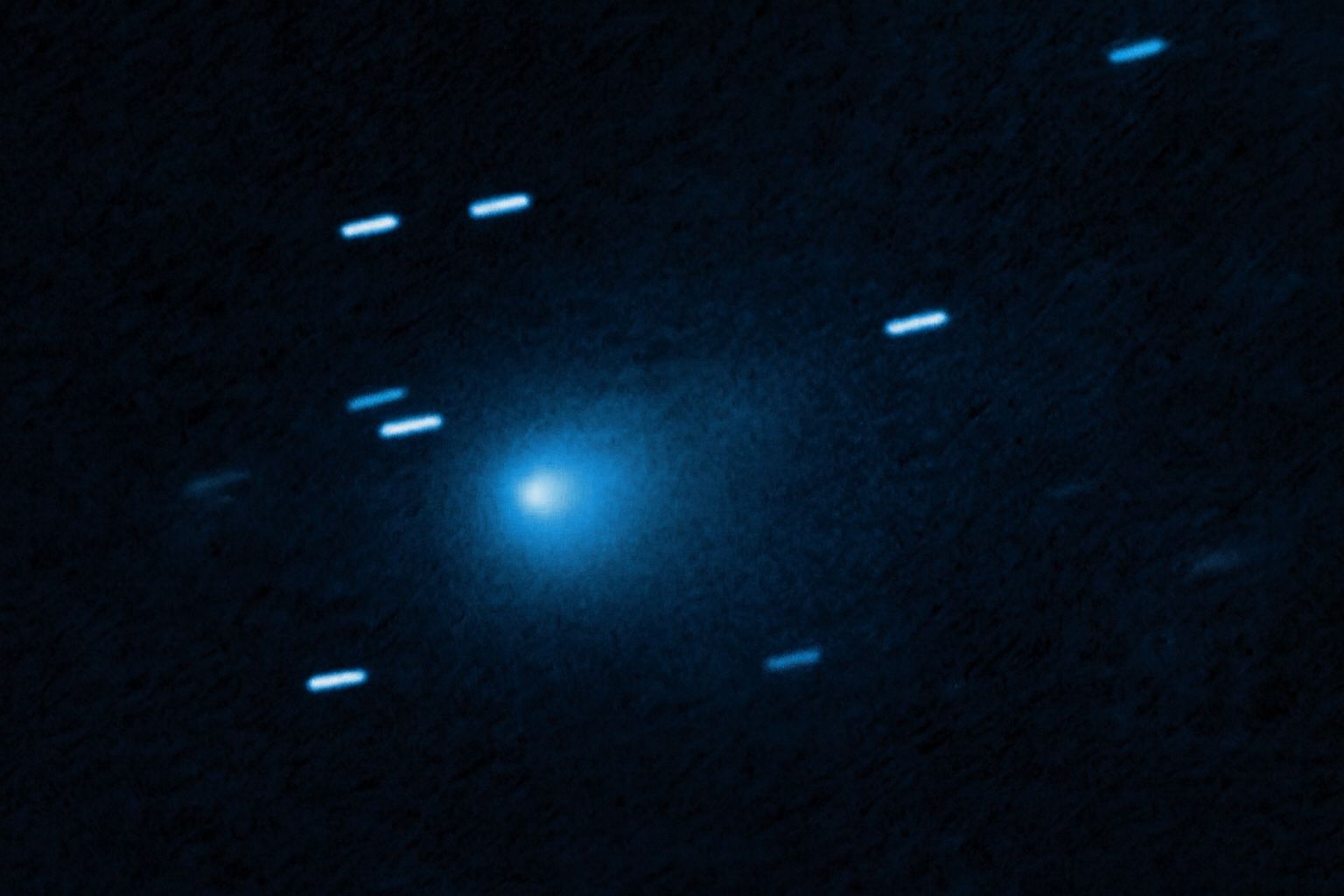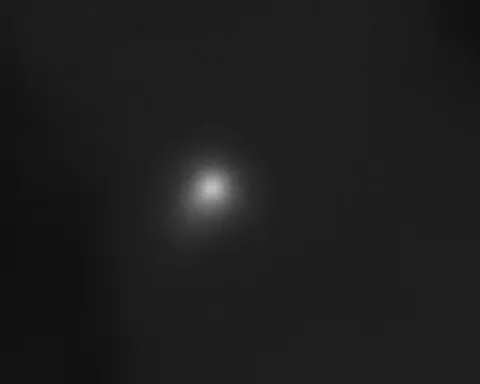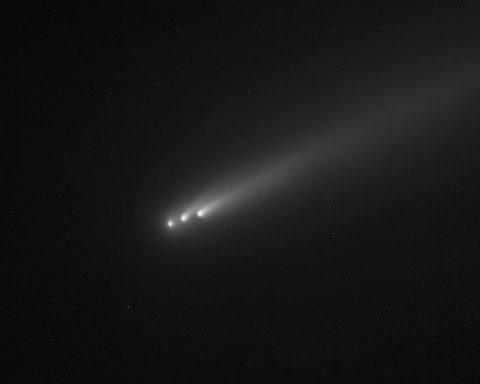- Third Interstellar Visitor: Comet 3I/ATLAS (C/2025 N1) is only the third known object from beyond our solar system – following 2017’s cigar-shaped 1I/‘Oumuamua and 2019’s comet 2I/Borisov [1]. Discovered on July 1, 2025 by the ATLAS survey in Chile, its unbound hyperbolic trajectory immediately flagged it as an interstellar interloper [2].
- Speeding “Ghost” Comet: 3I/ATLAS is hurtling through the inner solar system at ~58 km/s (about 130,000 mph) – far faster than typical comets [3] [4]. It’s on a one-way escape path: after slingshotting around the Sun, it will race back into interstellar space, never to return [5].
- No Threat to Earth: The comet reached perihelion (closest to Sun) around Oct. 29–30, 2025 at ~1.36 AU (inside Mars’ orbit) [6]. It stays distant from Earth – closest approach ~1.8 AU (270 million km) in December 2025 [7] – so it poses no danger (no “doomsday” impact) [8] [9].
- Too Dim to See Unassisted: Despite spooky season buzz, 3I/ATLAS is not visible to the naked eye. At Halloween 2025 it was around magnitude +11 and buried in the Sun’s glare [10]. It may reappear to telescopes by early December, but will remain a faint telescopic target (never a bright “Great Comet”) [11] [12].
- A Comet, Not an Asteroid: Unlike ʻOumuamua (which lacked a coma), 3I/ATLAS behaves like a normal active comet – it has a fuzzy coma and a tail of gas and dust [13] [14]. Hubble images clearly show typical comet features, confirming it’s venting material as it warms up [15].
- Record Size & Ancient Origin: Astronomers estimate 3I/ATLAS’s icy nucleus could be up to ~5 km (3.5 miles) wide [16] [17] – potentially larger than Borisov (~1 km) or ʻOumuamua (~0.1 km). Based on its galactic trajectory, it may hail from the Milky Way’s outer thick disk and be 7–11 billion years old – older than our 4.6 bn-year-old solar system [18] [19].
- Unusual Composition & Activity: 3I/ATLAS is surprisingly active even far from the Sun. NASA’s Swift observatory saw it spewing water at ~40 kg/s (≈88 lb/s) when it was 2.9 AU out – “about the equivalent of a fire hose at full blast” [20]. Its coma is rich in CO₂ but relatively low in H₂O and CO, unlike typical comets [21] [22]. Spectra also detected cyanide gas and even trace nickel vapor – offering clues that this comet formed in a very different star system [23] [24].
- Global Observation Campaign: 3I/ATLAS has prompted a worldwide (and off-world!) observing frenzy. Major Earth telescopes – Hubble, James Webb, Gemini, VLT and more – have been tracking it for months [25]. In early October, as it flew by Mars, ESA’s Mars Express and ExoMars Trace Gas Orbiter managed to photograph the comet (a faint dot ~30 million km away) [26] [27]. Coming up, ESA’s JUICE probe and even spacecraft like NASA’s Europa Clipper may sample the comet’s tail as it drifts through space [28] [29]. Scientists are seizing this once-in-a-lifetime opportunity to study an alien comet up close [30] [31].
- Haunting Hype vs. Science: Nicknamed a “ghost comet” due to its Halloween-timed visit, 3I/ATLAS has inspired fevered media chatter. Fringe theories abound – e.g. Harvard astronomer Avi Loeb speculated it might be an alien probe and warned of an “acid test” at perihelion [32]. Social media lit up with wild claims, but experts stress there’s no evidence of anything artificial: “It looks like a comet and it behaves like a comet,” says ESA scientist Michael Küppers, noting no alien signals have turned up [33]. In short, the only spooky thing about 3I/ATLAS is how much it can teach us about other star systems.
What is Comet 3I/ATLAS? An Interstellar Visitor from Beyond
Image: Interstellar comet 3I/ATLAS, captured by the Gemini South Observatory in late 2025, showing a diffuse coma and tail against the stars. This “ghostly” haze of gas and dust confirms that 3I/ATLAS is an active comet venting material as it nears the Sun. [34] [35]
Comet 3I/ATLAS is a rare celestial visitor that truly doesn’t belong in our solar system. Officially designated 3I/ATLAS (for “3rd Interstellar” object, discovered by the Asteroid Terrestrial-impact Last Alert System), it was first spotted on July 1, 2025 by an ATLAS telescope in Chile [36] [37]. Within days, astronomers realized this object was on a hyperbolic trajectory – in other words, it isn’t bound to the Sun by gravity and is just passing through our neighborhood [38]. That immediately marked it as interstellar, originating from beyond the solar system. “This is an object from a part of the galaxy we’ve never seen up close before,” noted Oxford astronomer Chris Lintott, whose team studied 3I’s orbit [39]. Scientists estimate that 3I/ATLAS may have been traveling through interstellar space for billions of years, possibly formed around an ancient star long before our Sun existed [40] [41].
Being the third confirmed interstellar object, 3I/ATLAS invites comparisons to its two predecessors. The first was 1I/ʻOumuamua, discovered in 2017 – a mysterious cigar-shaped body that showed no active coma, baffling scientists with its unusual shape and a slight non-gravitational acceleration [42]. The second, 2I/Borisov in 2019, was much more comet-like: it sported a visible coma and tail and was basically a chunk of ice from another star system. Comet 3I/ATLAS appears more similar to Borisov – it’s actively outgassing and shedding dust like a normal comet, not a dormant rock [43] [44]. However, 3I/ATLAS may be larger and more ancient than either ʻOumuamua or Borisov [45] [46]. Early Hubble observations set an upper limit of about 5.6 km across for 3I/ATLAS’s nucleus [47], which would make it a giant compared to ʻOumuamua (only ~100–200 m long) and somewhat bigger than Borisov (~0.9 km) [48]. Moreover, based on its high-speed galactic orbit, researchers think 3I/ATLAS could be 7–10 billion years old, possibly the oldest comet ever observed – “we think there’s a two-thirds chance this comet is older than the solar system, and that it’s been drifting through interstellar space ever since,” said Prof. Lintott [49]. In other words, 3I/ATLAS may be a preserved relic from a very early generation of planetary systems [50] – a kind of time capsule carrying clues from the galaxy’s distant past.
Trajectory, Speed and Visibility: A Cosmic Bullet in the Night
From the moment it was discovered, 3I/ATLAS’s path was clearly that of a one-time visitor. Its orbit is extremely eccentric (e = 6.14), indicating it’s not bound to the Sun [51]. In late 2025, the comet swooped in from above the plane of the planets on a steep retrograde path (inclined ~175°) [52]. It reached its closest point to the Sun (perihelion) around October 29, 2025, coming within ~1.36 AU of the Sun – just inside the orbit of Mars [53] [54]. At perihelion it was on the far side of the Sun relative to Earth, hidden in solar glare. After rounding the Sun, 3I/ATLAS is now on its way back out, destined to exit the solar system forever on a hyperbolic escape trajectory.
One striking aspect of 3I/ATLAS is its immense speed. As it whipped through the inner solar system, it reached velocities of about 68 km/s at perihelion, roughly 130,000 miles per hour [55] [56]. That’s faster than any comet previously recorded [57]. “It’s like glimpsing a rifle bullet for a thousandth of a second,” said UCLA astronomer David Jewitt, describing how hard it is to pin down 3I/ATLAS’s origin when it’s moving so fast [58]. Because of this extreme speed, the Sun’s gravity will only bend 3I/ATLAS’s path slightly; the comet is on a one-way trip that will fling it back into interstellar darkness. After perihelion, it will accelerate away, ultimately achieving a sun-relative speed (v∞) of about 58 km/s as it escapes the solar system [59]. By comparison, typical long-period comets from our Oort Cloud drift at a few tens of km/s. The hyper-velocity of 3I/ATLAS is a clear fingerprint of its alien origin – it needed that speed to break free from its home star and it won’t be captured by ours [60].
What does this mean for skywatchers? Unfortunately, 3I/ATLAS has been more of a trick than a treat for stargazers. Unlike some comets that flare into naked-eye view, this interstellar visitor stayed relatively faint. Around Halloween 2025, as media buzzed about a “ghost comet,” 3I/ATLAS was only about magnitude +11 and impossible to see without a decent telescope [61]. Moreover, at that time it was lurking too close to the Sun’s direction (a “solar conjunction”), rendering it essentially invisible from Earth [62] [63]. On the night of Oct. 31, 2025, the comet was located near the dawn horizon by Venus – haunting the sky, perhaps, but drowned out by twilight [64]. NASA noted that the comet will likely re-emerge from the Sun’s glare by early December 2025, climbing into darker skies [65]. However, by then it will be even farther away and fading, so only large telescopes may pick it up as a tiny smudge. It’s never expected to get bright enough for binoculars or the naked eye [66].
That said, 3I/ATLAS still offered some unique viewing opportunities – just not from Earth’s surface. During October, the comet happened to pass relatively close to Mars (about 30 million km on Oct. 3) [67]. Capitalizing on this geometry, scientists repurposed spacecraft orbiting Mars to observe the interstellar comet. In the first week of October, ESA’s ExoMars Trace Gas Orbiter and Mars Express turned their cameras toward 3I/ATLAS [68]. They managed to capture faint images: the comet appeared as only a tiny fuzzy dot – “10,000 to 100,000 times fainter than our usual target,” noted Dr. Nick Thomas, the ExoMars camera lead [69] [70]. It wasn’t much to look at, but it marked the first time in history that a spacecraft around another planet photographed an interstellar object [71]. Those Mars orbiter observations continued throughout early October as the comet sped by the Red Planet. Even while 3I/ATLAS was hidden from Earth, robotic eyes on Mars kept watch, a preview of the creative methods astronomers are using to track this visitor wherever possible.
Scientific Findings: Composition, Behavior, and Cosmic Clues
Though dim in our sky, 3I/ATLAS has been a goldmine of data for scientists. Telescopes around the world (and in space) have been scrutinizing its light to decode its composition and behavior. The picture emerging is of a comet that is familiar yet strange – it has much in common with comets from our own solar system, but also notable quirks that reflect its exotic origin.
One early surprise was just how active 3I/ATLAS became, even while it was still far from the Sun. By late summer 2025 – when the comet was out near Jupiter’s orbit – astronomers already saw it developing a noticeable coma and tail [72]. A team using NASA’s Neil Gehrels Swift Observatory (a space telescope) detected a telltale sign of water vapor in July: Swift’s ultraviolet instrument picked up hydroxyl (OH) gas, a product of water ice sublimating, when 3I/ATLAS was 2.9 AU from the Sun [73]. This is an unusually large distance to see abundant water outgassing – around three times farther out than where typical comets start “melting.” The researchers calculated the comet was shedding roughly 40 kg of water per second at that distance [74]. That rate, about 88 pounds per second, is comparable to a fire hose on full blast [75]. Such vigorous activity so early “rewrites what we thought we knew” about comet behavior, one scientist told Live Science [76]. It suggests 3I/ATLAS holds volatile ices (like subsurface water ice) that were exposed and heating up even in the chilly outer solar system. This finding was exciting because, as Swift co-investigator Dennis Bodewits put it, “when we detect water… from an interstellar comet, we’re reading a note from another planetary system” – proof that the ingredients for life’s chemistry (like water) aren’t unique to our solar system [77].
Analyzing the makeup of 3I/ATLAS has been a high priority. By splitting the comet’s light into spectra, scientists can identify gases and assess what ices the comet contains. James Webb Space Telescope (JWST) observations indicated an unusual chemical balance: very high in carbon dioxide (CO₂) relative to water [78]. In fact, early results suggest the coma might be ~95% CO₂ and only ~5% H₂O by volume – essentially the opposite of a typical water-rich comet [79]. This implies 3I/ATLAS formed in a colder, carbon-rich environment. Another odd clue was the detection of nickel gas in the coma [80]. Normally, elements like nickel and iron exist as solid grains in comet dust and only appear in spectra when very close to the Sun (if at all). Yet 3I/ATLAS showed gaseous nickel even when far out, while iron was not initially seen [81]. On Earth, “nickel without iron” is something you’d only get from industrial processes, as Avi Loeb provocatively noted [82]. One hypothesis is that the nickel could be coming from an exotic molecule like nickel carbonyl (Ni(CO)₄) in the comet – a volatile compound that breaks apart under sunlight, releasing nickel atoms [83]. If true, that would be a completely new chemistry for a comet. Scientists also identified familiar species: for example, cyanide (CN) gas was detected, which is common in many comets [84]. Overall, 3I/ATLAS seems to carry a mix of ices and dust akin to our own comets, but with a distinctive chemical fingerprint (CO₂-rich, and hints of unusual compounds) that speaks to a different stellar nursery. By studying these materials, researchers hope to glean how conditions in its home system differed from ours. “The comet’s strange composition – rich in CO₂ and metals – could simply mean it formed in an older, carbon-rich star system unlike ours,” one report noted [85].
The size and structure of 3I/ATLAS have also been probed. Even the Hubble Space Telescope cannot directly see the tiny nucleus inside the glowing coma, but Hubble’s sharp imaging placed bounds on it. Based on how the comet’s brightness diffuses, astronomers estimate the nucleus is at most about 5.6 km (3.5 mi) in diameter, and could be as small as a few hundred meters [86]. (For context, 5 km is big for a comet – that’s on the order of Halley’s Comet; a more likely size of ~1 km would be closer to average [87].) Either way, 3I/ATLAS is much larger than ‘Oumuamua was, which partly explains why it was discovered early and why it’s so active (more surface area to sublimate). Hubble also captured a dust plume jetting off the sunward side of the nucleus, feeding the coma, as well as a faint dust tail beginning to form [88] [89]. All of these are “typical features of a comet” at that distance, researchers emphasized, meaning 3I/ATLAS isn’t behaving exotically in terms of morphology [90]. So far, apart from its hyperbolic orbit and extreme speed, it looks and acts like an ordinary comet. “So far, only its velocity and hyperbolic trajectory mark it out as different,” one science writer observed [91]. This is an important point: despite the internet theories, nothing in the data screams “alien spacecraft” – if 3I/ATLAS weren’t moving so fast, we’d assume it was a garden-variety comet from our own Oort Cloud.
Crucially, studying 3I/ATLAS’s composition and activity gives astronomers a window into the chemistry of another solar system. As JWST and large observatories continue to take spectra around the comet’s perihelion period, they are looking for molecules like carbon monoxide (CO), methane, or other organics that might distinguish its birthplace. Interestingly, when the previous interstellar comet 2I/Borisov was studied, it was found to be very high in CO (much more than typical local comets) [92]. Each interstellar object so far has brought a few surprises, hinting at a diversity of planet-forming environments out there. 3I/ATLAS, with its ancient pedigree, could provide clues about the early Milky Way. If it indeed came from the galaxy’s thick disk, it might have formed when the galaxy was a younger, more turbulent place. As Dr. Adam Hibberd (one of the researchers modeling its origin) put it, it’s like a piece of the “cosmic dawn” delivered to our doorstep [93]. Even some of the heaviest elements in its dust can inform us – for instance, finding nickel and other metals in the coma at certain ratios might tell us about the protoplanetary disk chemistry around its parent star [94]. In short, 3I/ATLAS is teaching us not just about one comet, but about how other solar systems might be built.
A Global Effort to Observe the Once-in-a-Lifetime Comet
Astronomers across the globe (and beyond) have treated 3I/ATLAS’s visit as a rare chance to learn about an alien world – “literally a once-in-a-lifetime opportunity,” as one scientist exclaimed [95]. Because these interstellar objects are so fleeting and unpredictable, the community mobilized quickly. Dozens of telescopes have been coordinated to monitor 3I/ATLAS across different wavelengths. Notably, both the Hubble Space Telescope and the James Webb Space Telescope scheduled observations – Hubble provided high-resolution visual images [96], while JWST’s infrared vision is parsing the comet’s molecular fingerprints [97]. Major observatories on the ground, from Hawaii to Chile, have been snapping images nightly to watch how the coma and tail develop [98]. In the weeks around perihelion, the comet was also observed in radio and submillimeter bands (seeking signals of molecules like CO, HCN, etc.). This all-hands-on-deck campaign is unprecedented in some ways, surpassing even the effort for Borisov in 2019 [99]. “Some of the biggest telescopes in the world are already observing this new interstellar object – one of them may be able to find out [answers],” said Dr. Michele Bannister, a co-discoverer of interstellar objects [100], expressing the excitement 3I has stirred in the scientific community.
Perhaps the most innovative observations are coming from spacecraft that weren’t originally designed to study comets at all. We already mentioned the Mars orbiters that pivoted to capture 3I/ATLAS. Moreover, scientists realized that as 3I/ATLAS swings through the inner solar system, it might cross the fields of view of solar observatories. Indeed, in late October, the comet entered the view of instruments on the SOHO spacecraft (which watches the Sun) and NASA’s new Parker Solar Probe – these probes can monitor the comet’s dust and gas as it gets closest to the Sun [101]. Looking ahead, in November 2025 the European JUICE (Jupiter Icy Moons Explorer) spacecraft will attempt to observe 3I/ATLAS from a vantage point between Earth and Jupiter [102] [103]. Thanks to a timely gravity assist, JUICE will be positioned to take measurements near the comet’s perihelion time when Earth-based viewing was tough [104]. “JUICE will be in the best position around perihelion, when observations from Earth are the hardest,” explained Dr. Marshall Eubanks, who has been coordinating the interstellar observation strategies [105]. The closest any spacecraft will come is actually NASA’s Psyche probe (on its way to a metal asteroid) – Psyche will be about 45 million km from 3I/ATLAS at closest approach [106], while JUICE will be ~68 million km away [107]. These distances are still quite far (for comparison, Earth was 270 million km away at closest approach), but because the spacecraft have sensitive instruments, they can collect data the whole time the comet is in range.
Excitingly, two spacecraft might even encounter the comet’s tail. ESA’s Hera probe (which is in space for an asteroid mission) and NASA’s Europa Clipper (cruising toward Jupiter) are on trajectories that will carry them through the outer reaches of 3I/ATLAS’s tail in the weeks after perihelion [108]. If the comet’s tail is extended enough, these craft could directly sample the dust or charged particles from 3I/ATLAS – effectively giving us in situ data from an interstellar object without a dedicated mission [109]. “It depends on the direction of the tail… [but] they may pass through it,” said space scientist Dr. Andreas Hein, noting that a spacecraft flying through the tail could perform mass spectrometry on the dust/gas to reveal composition [110]. That prospect has researchers thrilled. “It’s like an aeon-old fridge, which will open during the next months to release some of its contents,” Hein added, poetically describing how 3I/ATLAS is shedding primordial material that spacecraft might catch and analyze [111]. Every bit of data – from telescopes or probes – helps build a more complete picture of this interstellar interloper.
The collective effort to observe 3I/ATLAS is truly global. Professional observatories have been joined by amateur astronomers and citizen science networks sharing images and measurements of the comet’s progress. Even though it’s faint, dedicated amateur astrophotographers have captured long-exposure shots of 3I/ATLAS’s ghostly tail sweeping across the stars [112]. Meanwhile, plans are afoot for future missions that could intercept an object like this. Researchers at the Southwest Research Institute, for example, have proposed a mission concept to rendezvous with a future interstellar comet – essentially a probe lying in wait to chase the next 1I, 2I, or 3I that shows up [113] [114]. ESA is already preparing the Comet Interceptor mission (due to launch in 2029) to do exactly that: it will park in space and be ready to redirect to any incoming pristine comet – possibly even an interstellar one [115]. As ESA’s Dr. Michael Küppers (Comet Interceptor scientist) noted, when that mission was planned we only knew of one interstellar object, now we’ve seen three with very “large diversity in their appearance”, so actually visiting one could be a breakthrough [116]. It’s unlikely we’ll get a probe to 3I/ATLAS itself (it’s moving too fast and was found on too short notice), but the knowledge gained now will pave the way for catching the next interstellar vagabond.
Cultural Buzz: The ‘Ghost Comet’ of Halloween
3I/ATLAS’s journey happened to coincide with the Halloween season of 2025 – a coincidence the media found irresistible. Headlines dubbed it the “Halloween interstellar comet,” the “cosmic ghost” haunting our solar system, and other spooky monikers. In late October, Space.com quipped that among the comets in the sky, 3I/ATLAS was “a skywatching trick” rather than a treat, since you couldn’t easily see it [117] [118]. The comet’s ghostly pale coma and the fact it came from the depths of space gave it an aura of mystery. Some outlets ran tongue-in-cheek stories about an “alien visitor for Halloween,” playing on the timing. Social media, unsurprisingly, ran even wilder. There were viral memes imagining 3I/ATLAS as a cosmic ghost or spaceship, and conspiracy theories linking the comet to Nostradamus prophecies and doomsday predictions [119]. Though fanciful, this buzz did increase public interest in astronomy for a time – people who might not normally follow comet news were asking what 3I/ATLAS was.
The hype was further amplified by a well-known (and sometimes controversial) Harvard astronomer, Dr. Avi Loeb. Dr. Loeb gained fame for suggesting ʻOumuamua might have been alien technology; this time, he floated similar ideas about 3I/ATLAS. In interviews and even on The Joe Rogan Experience podcast, Loeb speculated that 3I/ATLAS could be “alien tech” – perhaps a probe or vessel of some sort – and estimated “a 40% chance” it was not a natural object [120]. He pointed out some of the comet’s oddities (like its precise planar trajectory and that it passed relatively near Mars) and called those “remarkable fine-tuning… exactly what an alien probe might do to survey the planets” [121]. Loeb dramatically warned that the comet’s swing around the Sun would be an “acid test”: if it deviated from its expected path (say, made an unexpected course change), that could indicate intelligent control [122]. “It’s like going on a blind date with a cosmic visitor – we don’t know who or what is in control,” he told one outlet [123]. He even mused that if, hypothetically, 3I/ATLAS did something undeniably artificial, it “could trigger a global stock market crash,” such would be the shock to humanity [124]. These sensational comments grabbed headlines (hence the “Harvard scientist’s Halloween warning” stories). On Rogan’s podcast, Loeb went further, suggesting that even if the comet behaved normally, it “could still release smaller probes” – tiny devices – during its solar flyby to secretly study Earth or Mars [125]. This all sounds like science fiction, and mainstream scientists were quick to pour cold water on it. But it certainly contributed to the eerie mystique of 3I/ATLAS in the public imagination.
Amid the chatter, professional astronomers and space agencies worked to debunk the rumors and emphasize the facts. Both NASA and ESA released statements clarifying that 3I/ATLAS posed no danger to Earth and that its behavior so far was entirely consistent with a natural comet [126]. “It looks like a comet and it behaves like a comet,” stressed Dr. Michael Küppers of ESA, noting that nothing unusual (like radio signals or propulsion) had been detected [127]. The European Space Agency humorously tweeted that this interstellar visitor was “no alien invasion – just a really interesting rock!”. Scientists also addressed the so-called anomalies: for instance, the comet’s odd “anti-tail” (a dust jet pointing toward the Sun, observed in late August) got people buzzing online, but experts explained it’s a known phenomenon caused by dust grains and viewing geometry [128] [129]. “Extraordinary claims require extraordinary evidence, and so far 3I/ATLAS’s quirks have natural explanations,” one science article concluded [130]. In other words, while the idea of an alien spacecraft made for fun Halloween headlines, the consensus is that 3I/ATLAS is exactly what it appears to be: a comet – just one from another star.
Cultural framing aside, the real thrill of 3I/ATLAS is scientific. As people jokingly dressed as aliens for Halloween parties, astronomers were busy taking the measure of this interstellar ghost. “Icy wanderers such as 3I/ATLAS offer a rare, tangible connection to the broader galaxy,” ESA’s science team wrote – a reminder that behind the spooky nicknames lies a profound opportunity [131]. This comet is a piece of a distant solar system, now haunting ours for a brief few months. In a very real sense, 3I/ATLAS allows humanity to touch the stars: to study material that formed around an alien sun and see how it compares to the comets that whiz past our own skies. And that is why, long after the Halloween memes fade, 3I/ATLAS will be remembered by scientists. As astrophysicist Dr. Hein noted, such thick-disk interstellar objects might be exceedingly rare – it could be decades or more before we find another one like it [132]. We happened to get lucky in 2025: the universe sent us a ghostly guest, and we’re learning all we can from it. In the end, Comet 3I/ATLAS is less a harbinger of doom and more a messenger from afar, carrying secrets from the oldest reaches of our galaxy and sparking excitement here on Earth [133] [134].
Sources: Recent updates and reports on Comet 3I/ATLAS were compiled from NASA [135] [136], ESA [137] [138], Space.com [139] [140], Live Science [141] [142], Royal Astronomical Society press releases [143] [144], and TechStock² (ts2.tech) news analysis [145] [146], among other astronomy sources. These sources provide the latest scientific findings and expert commentary as of late October 2025. All linked articles are recommended for further reading on this interstellar comet’s journey and significance.
References
1. ts2.tech, 2. ts2.tech, 3. ts2.tech, 4. www.space.com, 5. www.space.com, 6. ts2.tech, 7. ts2.tech, 8. ts2.tech, 9. www.space.com, 10. www.space.com, 11. www.space.com, 12. www.space.com, 13. www.space.com, 14. www.space.com, 15. www.space.com, 16. ts2.tech, 17. www.space.com, 18. ts2.tech, 19. www.esa.int, 20. www.livescience.com, 21. ts2.tech, 22. www.livescience.com, 23. ts2.tech, 24. en.wikipedia.org, 25. ts2.tech, 26. ts2.tech, 27. www.esa.int, 28. ts2.tech, 29. www.space.com, 30. www.space.com, 31. www.space.com, 32. ts2.tech, 33. ts2.tech, 34. www.space.com, 35. en.wikipedia.org, 36. www.esa.int, 37. en.wikipedia.org, 38. en.wikipedia.org, 39. ras.ac.uk, 40. ts2.tech, 41. ras.ac.uk, 42. ras.ac.uk, 43. www.space.com, 44. www.space.com, 45. ras.ac.uk, 46. www.livescience.com, 47. www.space.com, 48. ts2.tech, 49. ras.ac.uk, 50. ts2.tech, 51. en.wikipedia.org, 52. en.wikipedia.org, 53. ts2.tech, 54. en.wikipedia.org, 55. en.wikipedia.org, 56. www.space.com, 57. www.space.com, 58. www.space.com, 59. en.wikipedia.org, 60. ts2.tech, 61. www.space.com, 62. www.space.com, 63. en.wikipedia.org, 64. www.space.com, 65. www.space.com, 66. en.wikipedia.org, 67. www.esa.int, 68. www.esa.int, 69. www.esa.int, 70. ts2.tech, 71. ts2.tech, 72. ts2.tech, 73. www.livescience.com, 74. www.livescience.com, 75. www.livescience.com, 76. www.livescience.com, 77. www.livescience.com, 78. www.livescience.com, 79. ts2.tech, 80. ts2.tech, 81. ts2.tech, 82. ts2.tech, 83. ts2.tech, 84. en.wikipedia.org, 85. ts2.tech, 86. www.space.com, 87. en.wikipedia.org, 88. www.space.com, 89. www.space.com, 90. www.space.com, 91. www.space.com, 92. www.space.com, 93. www.space.com, 94. ts2.tech, 95. www.space.com, 96. www.space.com, 97. www.livescience.com, 98. ts2.tech, 99. ts2.tech, 100. ras.ac.uk, 101. www.space.com, 102. www.space.com, 103. www.space.com, 104. www.space.com, 105. www.space.com, 106. www.space.com, 107. www.space.com, 108. www.space.com, 109. www.space.com, 110. www.space.com, 111. www.space.com, 112. www.livescience.com, 113. www.esa.int, 114. www.esa.int, 115. www.esa.int, 116. www.esa.int, 117. www.space.com, 118. www.space.com, 119. ts2.tech, 120. ts2.tech, 121. ts2.tech, 122. ts2.tech, 123. ts2.tech, 124. ts2.tech, 125. ts2.tech, 126. ts2.tech, 127. ts2.tech, 128. ts2.tech, 129. ts2.tech, 130. ts2.tech, 131. www.esa.int, 132. www.space.com, 133. www.space.com, 134. www.space.com, 135. www.space.com, 136. www.space.com, 137. www.esa.int, 138. www.esa.int, 139. www.space.com, 140. www.space.com, 141. www.livescience.com, 142. www.livescience.com, 143. ras.ac.uk, 144. ras.ac.uk, 145. ts2.tech, 146. ts2.tech









